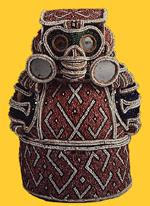SAN JUAN, Puerto Rico — Puerto Rico’s governor is proposing to solve soaring energy prices on this oil-dependent U.S. island with a massive natural gas pipeline that would cross some of the territory’s most fragile ecosystems and archaeological sites.
Gov. Luis Fortuno has made the $450 million project a central goal of his administration and he insists it is a safe, environment-friendly way to lower utility bills. Critics say the 92-mile (148-kilometer) pipeline will tear up lush green mountains and expose people living near it to deadly explosions.
The pipeline proposal, which Fortuno has dubbed “The Green Way,” also has sparked corruption allegations. The largest contract so far has gone to an engineering firm with no pipeline construction experience that is owned by a childhood friend of the governor. Fortuno has denied any conflicts of interest.
Puerto Rico has long struggled to overcome high power costs and rising world oil prices have hit the territory especially hard; it depends on petroleum to generate nearly 70 percent of its power. Electricity on the island costs about 21 cents per kilowatt hour, compared with an average of 10 cents per kilowatt hour on the U.S. mainland, according to the U.S. Energy Information Administration.
The last governor,
Anibal Acevedo Vila, proposed a 42-mile (68-kilometer) natural gas pipeline along Puerto Rico’s southern coast, but the $54 million project was scrapped in mid-2009 amid heavy opposition. Fortuno, in the early months of his administration, helped defeat the plan.
This time around, Fortuno is promoting an even larger pipeline proposal, despite similar resistance from activists. Even before he announced the project last August, his administration had awarded about $27 million in contracts — without public bids — for preliminary studies, according to documents filed with Puerto Rico’s Comptroller’s Office.
The documents show the largest contract, worth $9.6 million, went to Ray Engineers PSC, owned by a childhood friend of the governor,
Pedro Ray Chacon. Fortuno took a ski trip with Chacon before he became governor, said Ray spokesman Jose Cruz.
While Fortuno has said contracts for preliminary research didn’t require an open bid, senators from the island’s main opposition party are demanding an investigation into how the contracts were awarded.
“This entire process raises serious concerns that lacerate the confidence that people have in their institutions,” Puerto Rico Sen. Cirilo Tirado said in a statement.
At least a dozen municipalities have approved resolutions supporting the project in concept, and it has also been touted by the National Puerto Rican Chamber of Commerce and the local Association of Engineers and Surveyors.
“The failure to diversify energy sources has been the kiss of death for Puerto Rico,” said the engineers’ association president, Miguel Torres.
Despite all the political debates, the pipeline only needs final approval from the U.S. Army Corps of Engineers, which has been awaiting studies from the island’s energy authority and analysis from other federal agencies before making a ruling.
Government officials say cheaper natural gas brought by the pipeline would save $1 billion a year for the island of 4 million people. The pipeline would also reduce greenhouse gas emissions by 64 percent, they say.
Puerto Rico’s Electric Energy Authority estimates its customers will see a 30 percent drop in their bills if the pipeline is built.
“The Green Way project is an assured savings for Puerto Rico,” said Daniel Pagan, an engineer with the island’s power company and the project’s environmental consultant.
Controversy over the pipeline has erupted, however, in large part because of its sheer size.
The pipeline would originate in southern Puerto Rico, where billions of cubic feet of liquefied natural gas would be imported and regasified. The line would then bisect the island and veer east until it nearly reaches the capital of San Juan.
It would traverse 235 rivers and wetlands, cut through more than 60 miles (100 kilometers) of the island’s northern Karst region and possibly affect up to 32 endangered species, including the Puerto Rican parrot, crested toad and boa, according to the Corps of Engineers.
The pipeline also would cross 51 communities, placing as many as 23,000 families in danger of possible explosions, according to the nonprofit environmental organization Casa Pueblo de Adjuntas, which is leading the charge against the pipeline.
Archaeologists say the pipeline would run through historic sugar mill ruins and across petroglyphs carved centuries ago by Taino Indians.Nearly 8,000 people have signed an online petition created by Casa Pueblo to reject the pipeline, and organizers estimate nearly 30,000 people participated in a rainy May 1 protest to demand the project be scrapped.
“This was not a free and competitive process. This was done behind the country’s back,” said Arturo Massol, a microbiology professor and a Casa Pueblo spokesman.
Torres said some fears are exaggerated, because the project’s safety standards are higher than those set by federal agencies.
“What’s important to me is maintenance,” he said. “If maintenance is disregarded, that’s the concern.”
Much of the debate has focused on Fortuno, a rising Republican star who has been mentioned as a possible candidate for national office.
He declared an energy emergency last year that allowed the government to fast-track some energy projects due to the high price of petroleum.
“I signed an executive order to accelerate, not ignore, the permit process,” Fortuno said in a recent statement issued by his office. “Everyone who pays their monthly light bill, or fills up their car tank, knows we are in an emergency of great proportions.”
Attorney Pedro Saade, who is working with
Casa Pueblo, said the action shortened the required period the public had to learn about the project or file lawsuits to stop it.
U.S. Rep.
Luis Gutierrez, a Democrat from Illinois born to Puerto Rican parents, is a leading critic of the project and Fortuno. He has called the governor’s publicity push for the pipeline, which includes “Green Way” billboards erected around the island, an “Orwellian ad campaign.”
Gutierrez noted that as a gubernatorial candidate, Fortuno had said it would be a “grave mistake” to depend on natural gas.
“Now, he enthusiastically supports not just gas pipelines, but a much bigger, more environmentally disruptive and more expensive pipeline,” Gutierrez said.
Fortuno responded by reminding the congressman that natural gas kept him warm during the bitter East Coast winter.
“I hope he’s not pretending,” Fortuno said, “that he and the people who are in Congress have more rights than those of us who live in Puerto Rico.”
Author: Danica Coto
Source: The Associated Press

 http://www.uctp.org/index.php?option=com_content&task=view&id=701&Itemid=2
http://www.uctp.org/index.php?option=com_content&task=view&id=701&Itemid=2






























